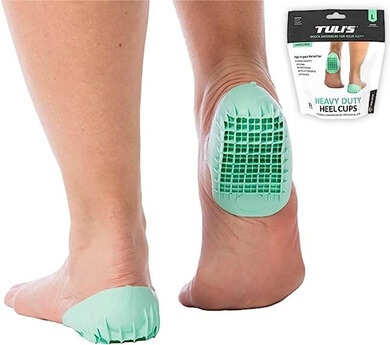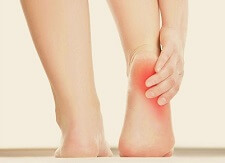- Home
- Common Foot Problems
- Bone Spurs
- Treatment
Heel Spur Treatment
Written By: Chloe Wilson BSc(Hons) Physiotherapy
Reviewed By: FPE Medical Review Board
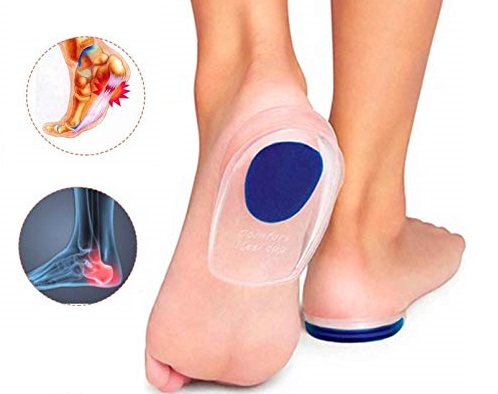
Heel spur treatment helps to relieve the pain and inflammation to allow you to walk without pain.
Heel spur treatment also aims to treat the cause of the bone spur, be it muscle tightness, inflammation or friction.
But what is a heel spur? Heel spurs are small lumps of excess bone that grow and stick out on the calcaneus, aka heel bone.
They usually develop in response to friction, tightness, inflammation or injury when the body lays down extra layers of bone to try and protect itself.
Where Do Heel Spurs Occur?
There are two areas where heel bone spurs tend to develop:
- At the Back of the Heel: these are usually due to conditions such as Achilles tendonitis, tight calf muscles or wearing tight footwear. These are known as posterior calcaneal spurs
- Underneath the Heel: these are usually due to conditions such as plantar fasciitis, muscle imbalance or altered foot biomechanics. These are known as inferior calcaneal spurs
Here, we will look at the different heel spur treatment options that can help. You can also find out more about the causes and symptoms in the Foot Heel Spurs Overview.
What Are The Best Heel Spur Treatment Options?
Heel spur treatment typically consists of a combination of some or all of the following:
1. Stretches
Stretching exercises are a really important part on heel spur treatment. Muscle tightness is a very common cause of heel spurs. Tightness in the calf muscles or the foot muscles places excessive tension on the area where the muscle attaches to the bone.
This repetitive tension irritates the bone and stimulates it to produce extra deposits of calcium to try and protect itself. By stretching out the muscles, you relieve this tension, allowing the heel spur to settle.
Stretching exercises for heel spur treatment will usually involve a combination of:
- Heel Stretches: to stretch out the soft tissues around the heel
- Calf Stretches: to stretch out the two calf muscles, gastrocnemius and soleus
- Foot & Ankle Stretches: to stretch out the foot and ankle muscles
- Plantar Fascia Stretches: to stretch the band along the bottom of the foot
You will find a whole range of stretching exercises for heel spur treatment using the links above.
2. Ice Therapy
Ice is another simple heel spur treatment. Applying ice regularly for 10-20 minutes every couple of hours to the affected area can help to reduce pain and inflammation.
You can use ice wrapped in a towel, instant cold packs or specially designed ice bags to treat heel spur pain. Find out more in the ice therapy section.
3. Anti-Inflammatory Medication
Non-steroidal anti-inflammatories (NSAIDs) such as Ibuprofen/Advil and Naproxen can help to reduce the inflammation and associated pain with heel bone spurs.
NB You should always consult your doctor before taking any medication as there can be side effects associated with taking these drugs.
4. Strengthening Exercises
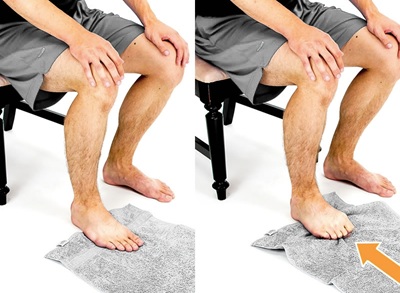
Heel strengthening exercises are another important part of heel spur treatment.
Strengthening the foot and calf muscles helps to reduce the tension on the muscles and tendons and helps support the various foot bones and arches. This allows the foot to move smoothly and efficiently.
A combination of strengthening exercises for the calf muscles and the intrinsic foot muscles is a vital part of a heel spur treatment programme – find out more about exercises for heel pain.
5. Foot Orthotics
There are a whole range of products out there that you can wear in your shoe as part of your heel spur treatment.
Heel Cups & Pads
Heel cups and pads are one of the best heel spur treatment options.
They provide support and cushioning to the heel bone making walking much more comfortable.
They also lift the heel slightly which reduces the tension through the calf muscles and Achilles tendon where they attach to the bone.
Heel cups simply slide into the back of your shoe and they can make a difference pretty much immediately. There are a whole range of styles out there – visit the heel cup section to find out about our favourites for heel spur treatment.
Shoe Inserts
Shoe inserts are great if your heel spurs are due to abnormal foot biomechanics such as fallen arches. They slip into your shoe supporting your foot arches reducing the irritation around the heel spur.
Find out more about our favourite shoe insoles that correct foot position and provide cushioning to the foot.
Padding
If your foot spurs are causing corns/calluses, wearing padding over these can make a big difference. Visit the Foot Corns/Calluses section for a whole range of treatment options.
6. Injections
Your doctor may suggest a corticosteroid injection as part of your heel bone spur treatment. This involves injecting a mixture of cortisone (a steroid) and local anaesthetic into the area to help reduce inflammation and pain.
The benefits of injections may last anything from a few days to a few weeks, but they can be a good way to settle things down enough so you can start the strengthening and stretching exercises part of heel spur treatment. You can find out more about cortisone injections on our sister site.
7. Weight Loss
If you are overweight, your doctor may recommend a weight loss programme as part of your heel spur treatment. This will help to reduce the force going through your feet and take some of the pressure of heel spurs.
Ninety percent of cases will resolve with these heel spur treatment methods. The spur may remain but the symptoms should ease if treatment is regular. It can take anything from a few weeks to a few months for the symptoms of heel bone spurs to settle completely.
8. Surgery for Bone Spurs
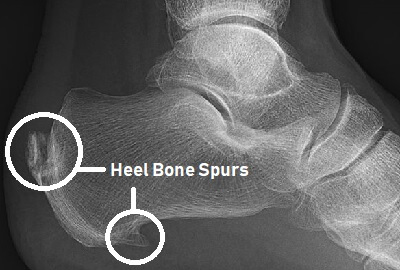
If you are still having problems after six to twelve months of aggressive heel spur treatment, your doctor may recommend surgery to remove the bone spurs. The operation may also be combined with a plantar fascia release to reduce the tension on the plantar fascia, a band on the sole of the foot.
Heel bone spur surgery is usually done under local anaesthetic. After surgery, you will need to continue with strengthening and stretching exercises to prevent the bone spurs from reforming.
What Else Can Help?
Heel spurs are often associated with other problems and so effective heel spur treatment, such as exercises for heel pain, relies on treating those conditions as well. You can find out more about the conditions in the following sections:
- Posterior Heel Spurs: Achilles Tendonitis & Haglunds Deformity
- Inferior Heel Spurs: Plantar Fasciitis
- Foot Bone Spurs: Corns/Calluses
To find out more about the causes and symptoms of bone spurs in the foot and heel, visit the Bone Spur Foot Overview.
Related Articles
Page Last Updated: 10th November, 2025
Next Review Due: 10th November, 2027
- Home
- Treatment Guide
- Treatment

